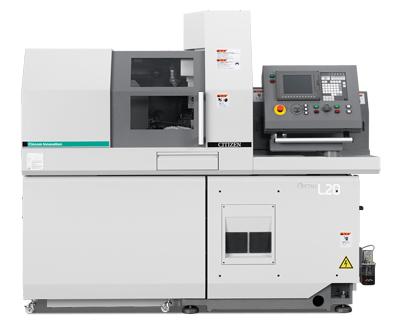
Marubeni Citizen-Cincom announced its next level in the Cincom L Series Innovation lineup, the L20 Type XII. With new B-axis controllable rotary tools, simultaneous complex machining is more accessible. This additional axis of control allows drilling and milling of angled features and contours without retooling or resetting, with a total range of 135 degrees, from 90 degrees to -45 degrees.
This allows the rotary tools to be used for both front and back machining. The Type XII also offers the flexibility of operating with or without the guide bushing. Install the guide bushing when machining long thin work pieces and remove it again for machining shorter pieces or when short bar remnants are required.
Other upgrades for this generation include:
• increased spindle through-hole diameter from 24mm to 26mm
• faster spindle speed of the gang rotary tools from 5000rpm up to 6000rpm
• faster spindle speed of back tool post rotary tools from 5000rpm up to 7500rpm
• increased gang tool post from 25 to 26 tools, raising the total possible tools from 39 to 40
• decreased power consumption from 8kVA to 7.3kVA
Many of these innovations come standard on the L20 type XII.
Contact Details
Related Glossary Terms
- bushing
bushing
Cylindrical sleeve, typically made from high-grade tool steel, inserted into a jig fixture to guide cutting tools. There are three main types: renewable, used in liners that in turn are installed in the jig; press-fit, installed directly in the jig for short production runs; and liner (or master), installed permanently in a jig to receive renewable bushing.
- gang cutting ( milling)
gang cutting ( milling)
Machining with several cutters mounted on a single arbor, generally for simultaneous cutting.
- milling
milling
Machining operation in which metal or other material is removed by applying power to a rotating cutter. In vertical milling, the cutting tool is mounted vertically on the spindle. In horizontal milling, the cutting tool is mounted horizontally, either directly on the spindle or on an arbor. Horizontal milling is further broken down into conventional milling, where the cutter rotates opposite the direction of feed, or “up” into the workpiece; and climb milling, where the cutter rotates in the direction of feed, or “down” into the workpiece. Milling operations include plane or surface milling, endmilling, facemilling, angle milling, form milling and profiling.
- through-hole
through-hole
Hole or cavity cut in a solid shape that connects with other holes or extends all the way through the workpiece.

